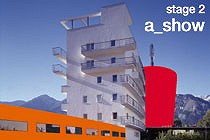
|
a_show. Austrian Architecture in the 20th and 21st Centuries Stage 2 Press Conference: Wednesday, 15 September 2004, 11am Opening: Wednesday, 15 September 2004, 7pm Exhibition: from 16 September 2004 Opening Hours: daily 10.00 am - 07:00 pm, Wedn. 10:00 am -09:00 pm THE EXHIBITION The first stage of the exhibition a_show. Austrian Architecture in the 20th and 21st Centuries opened in March 2004 to much success, as testified to by the thousands of tourists and people from Vienna and elsewhere with an interest in architecture who have already visited the show since. Due to the sheer scope of material covered by the exhibition, a_show is being subdivided into 10 themes to be opened successively in three stages. The complete exhibition will then be on permanent show at the Architekturzentrum Wien, providing a living showcase of Austrian architecture – as well as an invaluable tool for academics. The basic foundation of concepts behind the history of Austrian architecture worked on in the first phase of the exhibition, which covered the period 1850-1918, will continue to be on show but in a slightly condensed form as it is to be extended by the topics 'Red Vienna', 'Landscape', 'Power' and 'Post-War Reconstruction', i.e. the period from 1919-1958. The chronological order of certain phases in the development of architecture in Austria is described in terms of content and then illustrated on the basis of certain thematic aspects. Starting with the 'Prologue' of the first stage and the rise of Vienna to an imperial metropolis, in the second stage of the exhibition it is shown how numerous socio-political changes and the establishment of new cultural identities found their visible manifestation in the built reality of the country in the first half of the 20th century. In the field of tension between gestures of power, socio-political experimentation, the 'conquest' of Alpine space and the factual as well as symbolic period of reconstruction after 1945, the specific contribution of Austrian architecture to the international history of building is shown on the basis of exemplary projects. THE TOPICS COVERED IN STAGE 2 Red Vienna links directly to the period of the prologue in terms of content. Following the demise of the monarchy in 1919 Vienna was the first city of over a million inhabitants to have a Social Democratic administration, so attracting world-wide attention with its large-scale municipal housing development programme. Alongside numerous municipal housing complexes – and taking into consideration the qualities of the existing urban fabric – social facilities like municipal baths and kindergartens were also created. Landscape: The countryside as a symbolic construct played as much of a role in the Austrian sense of national identity as it did in ensuring an influx of foreign currency from tourism. In this context the adaptation of landscapes by building can be seen as the symbolic appropriation of land. Infrastructure projects to integrate tracts of countryside are shown alongside architectural stagings of the apparently naturally occurring topography. Power: Alongside the massive socio-political dismantling, the single party under Engelbert Dolfuss draws on Catholic social teachings to have a marked affect on the period and its built reality. Innumerable new churches become a vehicle for a programme of re-Christianisation, 'homeland-conscious' ties to old Austrian traditions dominate the iconographic programme of the architecture. When Hitler marched into Austria in 1938 the policies of persecution and banishment took on a new totalitarian dimension. Some of the most important proponents of Modernist architecture came from Vienna, although most of them were forced to leave Austria. The power gesture of the architecture empowered the regime's claim to political authority, especially in Linz. Reconstruction: Directly following the end of the war Austria had an enormous housing shortage to cover; speed and economy were initially the foremost criteria in building. Alongside the Viennese fast-lane building programme developed by Franz Schuster, the first signs of the optimistic reconstruction had been established and new approaches were tried out as part of the programme for the future. A new generation of architects was making its presence felt, criticising the new economics of functionalism in building and looking for other routes to take in the construction world. 66 projects arranged according to these topics are to be added to the exhibition from September 2004 and presented as a historical development on the varied basis of plans, documents, old photographs, company prospectuses etc. The overall exhibition is not a complete survey of building in Austria but weighted at specific points according to specific issues and brought closer to a broad public. Specially edited film footage take the viewer beyond the period from 1850-1958. While a time track with a clear chronology running along the walls of the exhibition places the architectural achievements of Austria in a broader cultural context. The first part of the 'little history of housing' (currently up to 1960) retains its presence in the exhibition as a specific topic of everyday relevance. THE EXHIBITION DESIGN: Design Studio Walking-Chair have developed an unpretentious workshop atmosphere especially for a_show based on a simple h-module of folded steel sheeting which reacts to the varying requirements of the overall display. A lively and varied accompanying programme has been compiled to accompany a_show: a_film showing on Austrian architecture of the 20th and 21st centuries/ a_show +guided tours of the exhibition and to examples in and around Vienna/workshops for children, young people and school groups. Opening of 3rd Stage (1958-now): Fall 2005 06 INTERNATIONAL I 07 SYSTEM I 08 IDEALISM I 09 COLLAGE I 10 THE PRESENT Curators: Gabriele Kaiser, Monika Platzer (project manager) Research assistance: Sonja Pisarik, Ute Waditschatka Film curator: Helmut Weihsmann |
 |
|
© Foto: Margherita Spiluttini |
|
Press page Current events Past events Gallery: Press images Stage 2 "a_show" Dates: a_show Stage 2 Information: Ines Purtauf Tel.: +43 (1) 522 31 15 - 25 Fax: +43 (1) 522 31 17 Email: purtauf@azw.at |
| © Architekturzentrum Wien 2025 |
||



